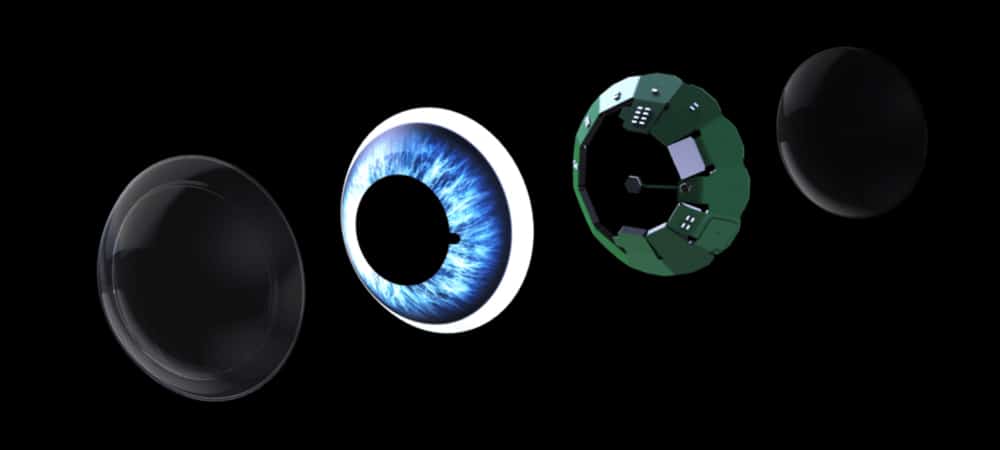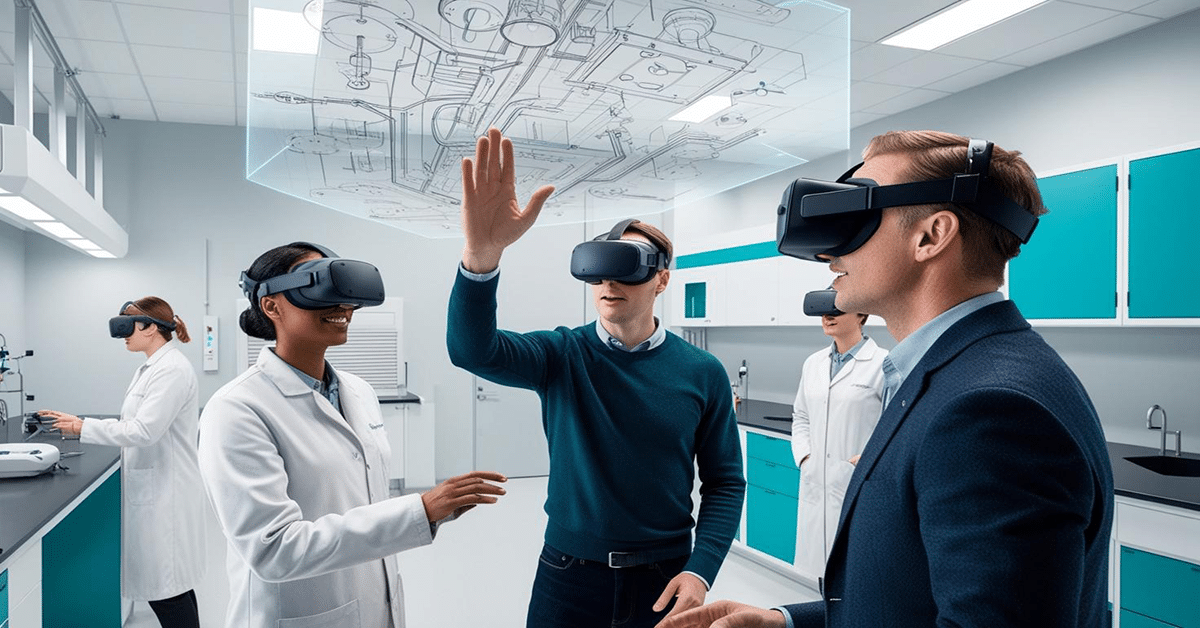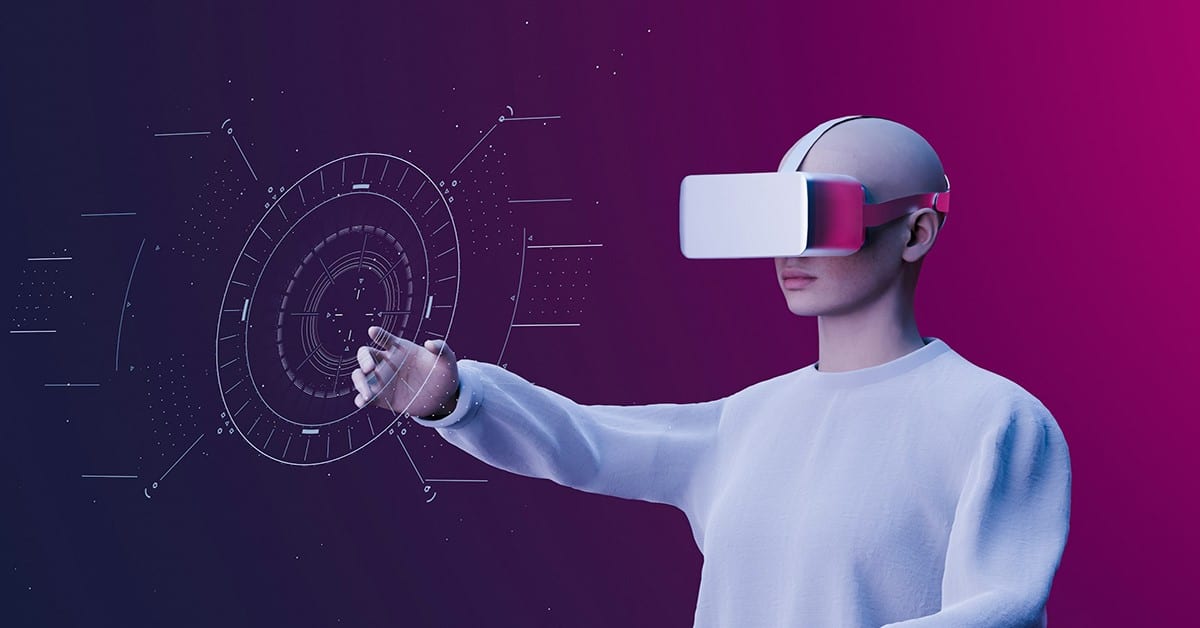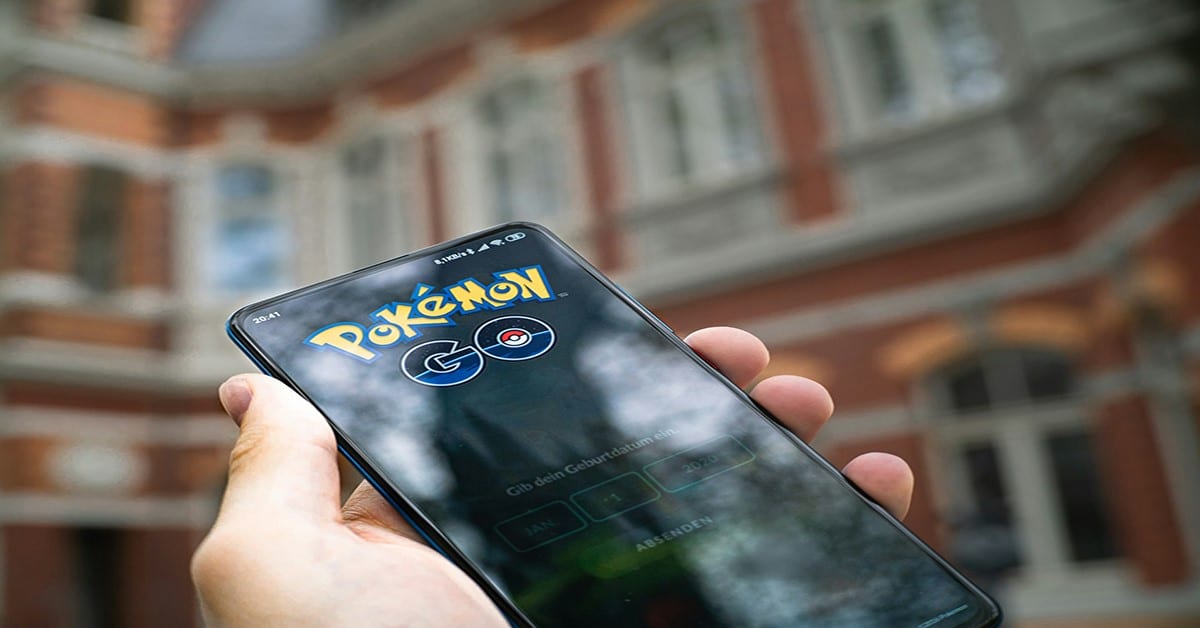Augmented reality (AR) is a groundbreaking technology that might seem quite mysterious at first glance. After all, it literally merges the online and offline worlds into a seamless whole. But while impressive, it’s also surprisingly easy to use. And you’ll soon know everything you need to begin exploring this new digital frontier. Your journey into the future starts here.
Quick Menu:
- Augmented Reality and the Larger Metaverse
- What Is Extended Reality?
- What Is Augmented Reality?
- What Is the Difference Between Augmented Reality, Virtual Reality, and Mixed Reality?
- Components of Augmented Reality
- Industries Using Augmented Reality Technology
- Most Popular Augmented Reality Devices
- Augmented Reality Concerns
Augmented Reality and the Larger Metaverse
If you’ve heard about augmented reality, there’s a good chance it was in the context of the larger metaverse. And to understand one, you need to understand the other. You can discover a general metaverse meaning by thinking of it as a separate digital universe alongside the physical or offline realm. If you “step into” the metaverse, it’s considered virtual reality (VR). This is done by donning a VR headset or similar device. If you bring elements of the metaverse into the offline world, then you’re using augmented reality. But the wide variety of metaverse-related technologies brings their permutation to this concept, encompassing headsets and even full masks or body suits. But they also include smartphones, game consoles, and computers.
The metaverse is also highly social, and you can bring friends and family along. And whether alone or in company, your actions in the metaverse will persist just as they would in the physical world. The metaverse is still in development, but you can explore it now. You can learn about the foundational elements of the metaverse in the article “Metaverse Guide; Understanding The Basics Will Open Up a New World”.
What Is Extended Reality?
Now that you know about the metaverse, it’s time to look at how people can use it. The various technologies that provide access to the metaverse are often referred to under the umbrella term of extended reality (XR). XR encompasses any technology that combines or bridges the real and virtual worlds. New forms of XR may arise in the future. But at the moment, XR contains augmented, mixed, and virtual reality. In the article “Extended Reality; What Is XR and How It’s Changing the Digital World,” you can delve into the full scope and future of extended reality.
What Is Augmented Reality?
Augmented reality differs from other forms of extended reality in balancing the physical and digital worlds. Virtual reality essentially moves people’s perception from the physical world to the digital. But augmented reality moves elements from the digital world into the user’s physical location. This typically works by blending the two modalities through mobile devices like smartphones or smart glasses.
AR data typically takes the form of 3D entities. But it’s also quite common for AR systems to present analytic, biometric, or technical information. The wide range of data partially explains why so many industries use AR. The same general technologies are equally applicable to a business setting, movie tie-in, and gaming service. AR even provides a wide range of presentations. It can add minor elements like real-time visual translations or blanket an area around the user with virtual landscapes.
What Is the Difference Between Augmented Reality, Virtual Reality, and Mixed Reality?
The differences between various forms of extended reality aren’t always noticeable. This is in large part because they exist within a larger continuum. Every type of extended reality technology is essentially sampling from the larger metaverse and will have some things in common. The distinctions generally come from how technology accesses the digital realm. Virtual reality immerses the user in a digitally generated 3D landscape.
Augmented reality enhances the user’s perception of the physical world by adding digital overlays. This is typically, but by no means only, done through a flat display. Smartphones are commonly used to access AR in this manner. AR can incorporate 3D entities aware of their environment. But this is more commonly found in mixed reality. MR sits between AR and VR by offering immersive projections.
In the article “Virtual Reality; Discover VR, Its Components, Technology, and Players”, you can learn more about VR.
And the article “Mixed Reality; Everything to Know About MR Technologies” expands on this newer mixed reality technology.
Components of Augmented Reality
Now that you’ve seen what augmented reality is, it’s time to see how the technology is actually implemented. AR is produced through the union of a wide range of different techniques and technologies. The following technologies are separated into hardware and software-based options, but they’re all among the most important components of augmented reality.
Augmented Reality Hardware Technology
Every element of the physical world needs a corresponding AR sensor for the two to integrate properly. The visual component of AR requires at least one camera. AR needs an accelerometer to track a user’s position within that physical area. The system will need GPS to detect where the user is positioned on earth. Even ambient light sensors that tell a device how bright an area is can be an essential part of AR.
But all of that information needs some powerful hardware to act as a primary workhorse for the effort. This is where a system’s processor enters the picture. Processors in AR act in a similar way to the ones in your phone or computer. They’re synonymous if you’re using your phone for AR. Finally, video processing is pushed by the processor directly to a digital screen.
Augmented Reality Software Development Kits
The software side of augmented reality is typically handled by an engine and software development kit (SDK). These packages consist of extensive collections of source code and techniques to work with augmented reality. SDK packages let developers start work with some of the foundational elements of AR already set out for them. If developers have a solid SDK to work with, they’re not stuck reinventing the wheel.
ARkit

Many people aren’t aware that Apple has been a big proponent of augmented reality for some time now. ARkit was Apple’s initial leap into the metaverse. It’s a complete augmented reality SDK for iOS devices. The SDK initially launched for iOS 11 back in 2017. The SDK has matured considerably over the years and is now in its sixth iteration. ARkit 6 was noteworthy for its inclusion of 4k video support. This made the already popular SDK even more sought after by people working in professional film production or media editing. ARkit made Apple one of the biggest AR companies.
ARCore

Apple’s biggest competitor in the mobile space also has a powerful AR SDK. However, ARCOre allows developers to create Android (7.0+), and iOS augmented reality apps using the same underlying code. ARCore is designed around three different key capabilities. These are motion tracking, environmental understanding, and light estimation. Google even made it easier to use these AR capabilities through the development and user testing of ARCore Elements. These AR UI components have been carefully tested to ensure that developers know exactly which techniques will improve a user’s immersion in the AR experience. Likewise, ARCore Elements highlights potential pitfalls to avoid.
Vuforia

Vuforia is an augmented reality SDK with a wide range of potential target platforms. This high level of compatibility is partly thanks to the SDK’s use of the Unity engine. This doesn’t mean that developers can quickly deploy AR apps for iOS, Android, and UWP. The ties with Unity also enable compatibility with many different programming languages. This includes C++, Java, Objective-C, and .NET. The SDK also makes heavy use of computer vision for its AR implementation. This makes it easy for developers to work with 3D objects, planer images, and addressable Fiducial Markers (VuMark) in real time.
Wikitude

Wikitude began life as an augmented reality app called Wikitude World Browser rather than an SDK. But over time, the company started to move many of the technologies from that app into a separate library. By 2012 this process culminated in the first release of the Wikitude SDK. Wikitude now provides most of the elements associated with AR. However, Wikitude puts additional emphasis on specific features. Geolocation is perhaps one of the most critical elements in Wikitude. The platform is also notable for cross-platform support. Developers can use the Wikitude SDK to create Android, iOS, and Windows AR apps.
ARToolKit

ARToolKit is especially notable as an open-source SDK that’s hosted on GitHub. Developers can make use of this powerful augmented reality SDK for free. But the genuinely revolutionary benefit of an open-source SDK stems from the fact that anyone can add functionality to it. If there’s a feature someone’s always wanted in an AR SDK, then he can add it and make the changes available to others. The SDK is written in C++ and has a class-based API that provides both power and ease of use. One of the SDK’s most significant claims to fame is its natural feature tracking system.
EasyAR

EasyAR is another augmented reality SDK that developers can download and use for free. The SDK has many powerful features like multi-target tracking, power management, and a variety of optimizations. But perhaps EasyAR’s most prominent feature is right there in the name – it’s easy to use. The SDK’s general syntax has been designed for ease of use. And EasyAR also comes with easy-to-follow examples for those who learn best by actively tinkering with existing source code. The code examples highlight how easy it is to implement video playback and even AR-based translucency for the resulting multimedia stream.
Augmented Reality Hardware Types
You’ve seen the variety of software development platforms targeting augmented reality, but there’s an equally impressive number of hardware platforms to work with. The following options highlight the most popular types of AR devices currently on the market. Each of these different types highlights particular aspects of augmented reality.
Mobile AR
Mobile AR combines augmented reality software with mobile devices like smartphones and tablets. Vuforia and Wikitude were among the first AR SDKs to target the platform. But the biggest game changer occurred in 2017 when Apple’s ARkit was released and integrated into iOS. Google followed Apple’s lead and released ARCore for Android in 2018. Mobile AR is far from the most potent or immersive AR platform. But it’s easily the most popular, thanks to the ubiquity of smartphones. Even people who don’t know what AR is may have spent hours with AR games like Pokémon GO.
Video: Pokémon GO – Get Up and Go!
Data Glasses
Data glasses provide augmented reality functionality in a form factor that aims to be nearly identical to standard glasses. Developers ultimately want data glasses to remain totally inconspicuous when in use. However, the need for smaller form factors also places technical limitations on how much they can accomplish now. Google Glass and North Focals superimpose information in your field of view. In contrast, Nreal Air beams virtual screens outward. Some data glasses like Ray-Ban Stories don’t even have video output and act as hidden cameras or speakers. Inconpicuousness is largely vital due to the poor public response to Google Glass.
Video: Ray-Ban Stories: the new way to capture, share & listen
AR Headsets
Augmented reality headsets sacrifice inconspicuous form factors for power. They’re closer to the virtual reality headsets offered by metaverse companies than they are to data glasses. While bulky, the added power vastly amplifies what they’re capable of. The more prominent form factor and high price have largely confined AR headsets to professional workplaces. And examples like the Hololens 2, Magic Leap 2, and Microsoft Hololens have made rapid progress within those spheres. But with that said, it’s clear that more innovations are needed before augmented reality headsets can be successfully marketed to the public, like VR headsets.
Video: Sigur Rós in collaboration with Magic Leap Studios | Tónandi
Video AR Headsets
Video AR headsets are often lauded as the best hardware for near-future developments in augmented reality. This is largely because the hardware on these devices is quite similar to that found in VR headsets. Even more so than standard AR headsets. Cameras in the headset’s housing transmit data to internal opaque screens. Digital information can then be easily overlaid on those screens to produce lifelike augmented reality. Recent technological advances make modern video AR headsets a huge leap forward compared to past implementations. For example, newer headsets provide improved physical masking, shadows, and transitions.
Video: Lynx, Video AR Headset
AR Glasses
AR glasses are the ultimate goal for many metaverse brands and developers. Perfect AR glasses would be able to project holograms into the real world while also blending augmented reality into the user’s field of vision. You’d be able to shift from personal to public augmented reality seamlessly. Michael Abrash, one of Meta’s most essential researchers, believes that the idea will ultimately succeed or fail based on the laws of physics. It’s unknown whether that much power can fit into a glasses-sized form factor. AR glasses need potent processors and at least two cameras and can’t be too heavy or hot.
AR Contact Lenses
AR content lenses are still in an early stage of development. But start-ups like Inwith and Mojo Vision have proven these devices feasible. Current augmented reality contact lenses don’t offer much in terms of direct functionality right now. They’re more proof of concept as companies work out how to fit advanced functionality into a contact lens. But with that in mind, what’s been created so far is breathtaking. Future advances in AR contact lenses will probably come alongside distributed computing and cloud technologies. The future of AR contact lenses is as exciting as it is unpredictable.
Video: Mojo Vision: This is the first AR contact lens
Industries Using Augmented Reality Technology
There’s a lot of fun to be had with personal augmented reality. But professional use is growing by the minute. The following examples highlight some of augmented reality’s most exciting professional usage scenarios.
Retail & Shopping
Retail has been one of the first and most important to embrace extended reality concepts like metaverse cryptocurrency. And it’s little surprise to find that several stores have integrated augmented reality into their systems. This is especially true for retailers who sell furniture and furnishings. For example, IKEA’s “IKEA Place” app lets you virtually place over 2,000 pieces of furniture in your home to see what it looks like. Concerns over buying furniture only for it to clash with your home’s style are a thing of the past.
Video: Power of AR in Retail
Healthcare
Healthcare may well be one of the most important matches for augmented reality systems. Medical practices such as surgery are challenging to practice in consequence-free environments. But augmented reality can instantly call up simulations of those tasks. And this is equally true for anything that a medical student is tackling at the moment. AR has aided even note-taking. Estimates suggest that physicians using AR to take notes have shaved an average of about two hours from their average day. It’s not just about having notes on hand, either. AR also increases the accuracy of note-taking and retrieval.
Video: Explaining Augmented Reality in Medicine In One Minute
Maps & Navigation
Mobile devices and always-on Internet connections have revolutionized how people navigate, whether that’s on the road or on foot, but AR is taking things a step further. Augmented reality is even being integrated into many popular navigation apps. For example, Google Maps has an AR navigation mode that lets you see pathfinding indicators in the physical world while you’re on foot and similar functionality is being integrated into Apple’s products thanks to ARKit 5. Auto manufacturers also note these concepts and update their infrastructure accordingly. Some cars can even display directions and road conditions on their windshields.
Video: Google Maps: New Augmented Reality Features
Archaeology
Archeology might seem like an odd match for high-tech augmented reality systems. But imagine the usefulness of virtually laying out possible ancient structures on top of unexcavated areas. Archeologists can now quickly extrapolate visual recreations of ancient buildings or even people to help investigate possible remnants of the past. Custom systems like VITA (Visual Interaction Tool for Archeology) have been specifically developed for use by archeologists. Augmented reality systems can make it easy for archeologists to investigate areas remotely with on-site teams. AR is helping link the past and future by aiding archeological investigations.
Video: ARCore Google – Augmented reality in the archaeological site of Selinunte
Education
New technologies have always been a boon to educators. The most prominent challenge teachers face is how to actually engage kids with the material. Advances in multimedia have helped highlight the relationship between material and real-world scenarios. But augmented reality, in particular, has impressive potential to bring lessons to life for the students. Even going over textual material can become an interactive game by providing something like hyperlinks within books. AR can change passive learning into an active experience. And anything that engages students in a more active role has been proven to aid learning and retention of lessons.
Video: Augmented Reality in Education
Industrial Manufacturing
Changes in how students approach books are only part of augmented reality’s impact on people’s relationships with authoritative material. AR is rapidly becoming an essential part of industrial manufacturing because it lets people instantly browse technical documentation. The users can then have relevant material pinned to their point of view while working on the machines. This makes people’s jobs considerably more manageable. But in doing so, AR also makes their jobs safer. The more efficiently someone works, the fewer dangers they face from industrial machines. And AR can even highlight potential threats during on-site repairs.
Video: Augmented reality in use for industry 4.0 and building technology
Gaming
If someone’s used augmented reality, the chances are that it’s in the gaming context. Pokémon GO is one of the most easily recognized examples of AR among the general public. The game wasn’t just a groundbreaking success in terms of its popularity. Pokémon GO also introduced people to the idea of AR. Pokémon demonstrated that their smartphones could bring them into that world. Augmented reality games are typically tied into mobile AR systems. Most people interested in AR gaming look at mobile markets for their needs. But there are exceptions, such as Jedi Challenges on Lenovo Mirage.
Video: Lenovo Star Wars Jedi Challenges hands-on
Live Sports Broadcasting
The sports industry has become a surprisingly good match for XR tech. For example, exceptional moments in sports can be celebrated as an NFT. But the biggest draw for sports fans is the idea of actually getting more out of any given match. Broadcasts are experimenting with adding extra overlay augmentation through tracked feeds from cameras. And swimming telecasts often use an overlay marker to show record-breaking metrics. But advertisers are also getting into it with specified sections of a field featuring AR branding. This can be selectively detected and overlaid with region-specific sponsors or brands.
Video: BT Sport – AR/VR/XR enhancing sports broadcasts with 5G
Most Popular Augmented Reality Devices
Until this point, the discussion around augmented reality has focused on hardware as a generalized concept. You’ve seen how AR hardware is categorized. But now it’s time to dive in and see specific AR hardware that you can try out for yourself right now.
Microsoft HoloLens
Microsoft’s HoloLens is easily one of the most successful augmented reality devices in the professional sphere. Both offices and manufacturing plants benefit from the device’s advanced AR capabilities to the point where, aside from mobile AR, it might be the most popular AR device on the market. It’s a well-earned success, as the HoloLens combines revolutionary innovations in processor design with advanced optics, sensors, and holographic implementations. The HoloLens features optical sensors on the sides for environmental understanding and context and a downward-facing camera that monitors the user’s hands for gesture input. Even the sound system is immersive.
Video: Introducing Microsoft HoloLens 2
Google Glass Enterprise Edition 2
Google Glass was most people’s first introduction to the idea of wearable augmented reality glasses. This was also the public’s first chance to consider the privacy concerns inherent to wearable electronics. This kept Glass from a publically available release. But the device caught on in professional spaces. The latest version of Glass provides a 640×360 RGB display, perfect for technical materials or instructions. And most users focus on this aspect to take advantage of hands-free access to notes and documentation. You can discover more about Glass in the article “Google Glasses; Learn About Google Glass Enterprise Edition 2”.
Video: Glass Enterprise Edition 2
Magic Leap
Magic Leap is one of the more well-established augmented reality companies. It was founded in 2010, focusing on virtual reality and related concepts. Magic Leap also has an impressive AR headset by the same name. The Magic Leap 1 headset has all the power of a standard computer. But it combines that power with a lightweight 316g design. It can even display heavy-duty 3D renders and fully integrate them into the physical world around you. This advanced integration is primarily thanks to a combination of the multi-processor design and a host of dedicated sensors that monitor your environment.
Video: Magic Leap 2
Mojo Vision Lens
The Mojo Vision Lens is one of the most advanced augmented reality devices. Glasses sized devices are a challenge for developers, but these lenses pack AR into a contact lens. It’s important to note that these AR lenses are still in a very early development phase. However, they do work in real-world tests. This is mainly due to innovations that pack a 14,000 pixel-per-inch display into a 0.2″ lens. The device can even use your contact lens prescription. You can discover more about this groundbreaking technology in the “Mojo Vision; Learn About Mojo Smart Contact Lenses” article.

Image attribution: Mojo Vision
Ray-Ban Stories
Fashion and metaverse-related concepts have gone together almost since the start. For example, NFT art combines blockchain with artistic inspiration, which can also be found in hardware. Ran Ban Stories are a popular form of augmented reality data glasses. They also mark a fusion of high-tech work from Meta (formally Facebook) and Ray-Ban. It’s essentially fashion merging with technological functionality. The result is a sleek pair of glasses that can record and celebrate your life. The article “Ray-Ban Smart Glasses; Ray-Ban Stories, Features, Prices & More” can explore more of the device’s history and style.
Video: Ray-Ban Stories
Augmented Reality Concerns
At this point, augmented reality might sound like a perfect technology. But it’s essential to keep in mind that the technology is still in a very early state. Everyone involved with AR, from users to developers and regulators, is still figuring things out. And there are some valid concerns to be found on the subject.
Fragmentation is one of the most serious issues. There aren’t any solid rules or guidelines within the industry. Every developer, distributor, and company working with AR has a different idea of what should be allowed. Lack of legal regulation means you can’t even rule out malicious software.
On top of this, there’s also the problem of expectation. AR is still new enough that most people don’t know what it’s capable of. Expectations are often far too high or far too low. These views have resulted in a vast array of apps that exist as little more than tech demos.
Perhaps the most crucial thing for AR in the future is awareness and growth. People need to consider exactly what the technology can offer. And companies need to continue the discussion on standards to create a stable platform.
The next step in your augmented reality journey is up to you. You’ve seen the tech and what various platforms offer. But only you can say which AR option will be the perfect fit for your digital exploration.
Did You Like This Article About Augmented Reality?
You might also be interested in the following articles:
- Metaverse Trends; Upcoming Milestones for the Digital Frontier
- Metaverse Startups; 10 Compelling Metaverse Startup Companies
- Apple Metaverse; How Apple Enters the New Digital Frontier









Leave A Comment